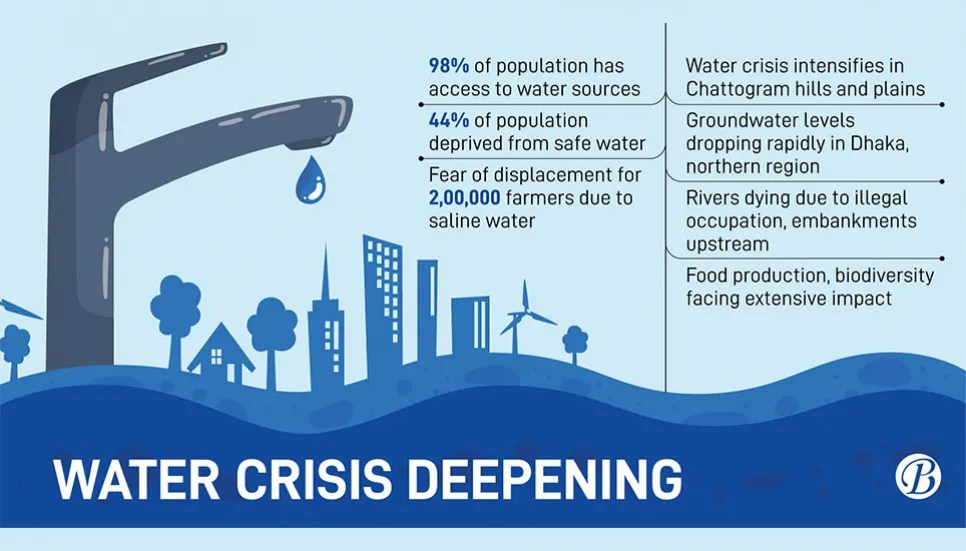
In Bangladesh, a country known to have plentiful water resources, the threat of a water crisis is now looming larger than ever as the scarcity of water is spreading increasingly to more and more areas — from the coastal areas to the plains of Chattogram hills.
Experts have warned that this scarcity will jeopardise food production, biodiversity and human health across the country.
“Urgent action, including improved water management practices, sustainable use of water resources and climate resilience measures, is needed to address the water crisis. Failure to act swiftly may have devastating consequences for Bangladesh's future,” said Professor Adil Muhammad Khan of the Department of Urban and Regional Planning at Jahangirnagar University.
The warnings came just a day before the country observes World Water Day 2024 alongside the rest of the world on Friday.
The demand for clean water in various parts of the country, including the capital city, is not a new phenomenon. However, the quality of available water sources remains a concern, with many reports of contamination.
Experts have attributed these issues to weak water management practices, exacerbated by climate change. Despite seemingly plentiful water resources in rural areas, the acute crisis of clean water persists throughout the year, particularly worsening at the onset of summer.
Salinity in Khulna, Satkhira, Bagerhat, Barguna, Patuakhali and other coastal districts has reportedly rendered water from most tube wells unfit for consumption, forcing residents to resort to using saline water, which in turn leads to various health problems.
‘’The increasing salinity, attributed to climate change, affects both water bodies and lands in various areas of Khulna region, exacerbating the severity of the water crisis especially in remote areas with limited access to clean water,” said Farhad Hossain, an NGO officer working on water resource management.
The residents of the coastal region are experiencing a severe water crisis due to salinity, with concerns escalating as the rainy season approaches. As monsoon rains begin, brackish water infiltrates ponds and other water bodies, persisting until the end of the rainy season. Residents in these areas are well aware of the health risks associated with consuming saline water, but they do not have any better alternatives.
Kakoli Rani, a resident of Mongla in Bagerhat, said, "Drinking water with high salinity from the pond causes various waterborne diseases such as dysentery, cholera, and diarrhoea. Moreover, skin diseases and even incidents like miscarriages among women are happening.”
In Shyamnagar Upazila of Satkhira, water scarcity intensifies during the dry season, leaving residents, even those living 8-10 kilometres away, struggling to access potable water, said locals.
Similar situations are also observed elsewhere across the country, further highlighting the widespread nature of the crisis.
Reports from the World Bank (WB), World Health Organization and UNICEF indicate that while 98 per cent of Bangladesh's population has access to water sources, only 56 per cent have access to safe water. Contamination affects 44 per cent of the population, with existing sources of safe water gradually becoming polluted.
A recent WB research also revealed alarming statistics, saying that 80 per cent of water supplied through pipelines in Bangladesh contains harmful bacteria. Similarly, ponds also exhibit high levels of bacterial presence, further exacerbating the health risks associated with water consumption.
Experts said the water crisis is worsening due to the rapid decline of groundwater levels, particularly in areas like Dhaka, Narayanganj, Gazipur and Barind regions, along with coastal areas.
Adil Muhammad Khan pointed out that the depletion of surface water sources, encroachment on rivers and canals and the drying up of freshwater sources are all contributing to the decrease in clean water sources on the earth's surface.
Recent climate change research has predicted dire consequences for Bangladesh's agricultural sector, with increasing salinity levels making lands unsuitable for rice cultivation, affecting millions of farmers in coastal regions.
Since the devastation caused by cyclones Sidr and Aila, clean water sources in coastal areas have been severely affected, further exacerbating the crisis.
According to Bangladesh Agricultural Development Corporation (BADC) reports, a staggering 192 upazilas spanning 41 districts are experiencing acute water scarcity.
The situation is particularly alarming in Dhaka city, where the water level has plummeted to a staggering 212 feet below the surface, raising concerns of future contamination by saline water.
Professor Graham Kogley of Trent University in Canada has warned that the unregulated extraction of groundwater in countries like India, Pakistan and Bangladesh poses significant dangers to the environment and public health. Alarmingly, approximately half of the groundwater in Bangladesh has become unsuitable for use due to high levels of salinity and arsenic.
The Intergovernmental Panel on Climate Change (IPCC) has further warned that rising temperatures are diminishing the availability of safe water, with a projected 20 per cent reduction for every degree increase.
If current trends persist, it is estimated that 40 per cent of the world's population will face water shortages by 2030, worsening the already devastating impact of waterborne diseases, according to IPCC.